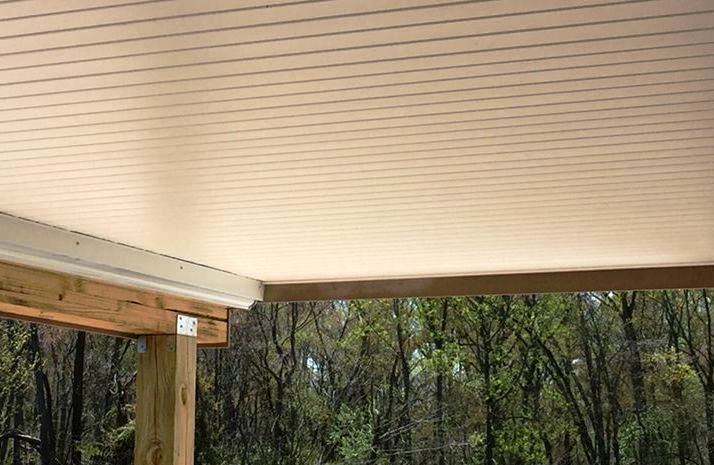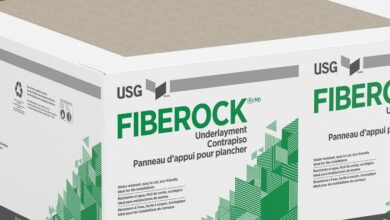Vinyl for Under-Deck Ceilings?

The advantages of an under-deck ceiling are numerous. It enables you to design a comfortable and useful outdoor area. You will be protected from the sun and rain when you construct an under-deck ceiling. It can also improve your deck area’s aesthetics.
When constructing the underside of your deck ceiling, also referred to as the soffits, there are numerous materials that you can use.
Today, we’ll talk in-depth about vinyl soffits and whether or not it’s the best material for an under-deck ceiling.
What Material Is Best For Installing Vinyl Soffit Under Deck Ceilings?
A variety of materials, including fiber cement, vinyl, steel, aluminum, wood, and hardboard, are available for soffits for under-deck ceilings. Every material has special qualities of its own. So, under a deck ceiling, are vinyl soffits the ideal material to use?
Soffits made of vinyl are an affordable and long-lasting option for an under-deck ceiling. There are various finishes available for vinyl soffits, including freshly painted wood.
The best thing about utilizing this material is that it doesn’t need much upkeep and can withstand water and moisture damage.
You can choose from a variety of finishes, colors, and textures when it comes to vinyl soffits. As a result, employing this material will greatly enhance the deck area’s aesthetics.
We must enumerate the benefits and drawbacks of vinyl soffit in order to decide if it is the ideal material to install beneath a deck ceiling.
Benefits Of Vinyl Soffits For Ceilings Below Deck
- Inexpensive: Vinyl soffits are a popular choice among homeowners for the underside of deck roofs primarily due to their low cost.
Vinyl soffits are relatively inexpensive when compared to alternative materials like wood. You can save a great deal of money if you want to cover a large deck with vinyl soffits.
- Low Maintenance Needed: After installation, cleaning vinyl soffits will be your only maintenance task.
Vinyl doesn’t require upkeep or touch-ups. Therefore, for homeowners who lead busy lives, it’s the ideal under-deck ceiling.
- Resistant to Moisture: Water damage is likely something you have encountered if you have ever installed a wood under-deck ceiling. Vinyl soffits have the advantage of having a high level of moisture and water resistance.
Vinyl soffits are the best option if you live in a rainy area because they will always be more resistant to water and moisture.
- Exceptionally Durable: If you install high-quality panels from a reputable manufacturer, vinyl soffits can endure for an exceptionally long period. Vinyl does not deteriorate or break down like other materials do. It will last for years as your under-deck ceiling.
- Available in a Variety of Finishes: Vinyl soffit comes in a range of colors and finishes. No matter how particular your tastes are, vinyl soffits make it simple to achieve the finish and color you want. Additionally, you can always repaint your panels to change things up if you get tired or bored of a particular finish.
- Insect-Resistant: You won’t ever wake up to find an infestation of insects on your deck ceiling because insects cannot feed on plastic.
Drawbacks of Using Vinyl Soffits for Basement Ceilings
- Mold Can Form in Damp Areas: One of the primary issues with vinyl soffits is the potential for mold growth in your under-deck ceiling’s damp areas. When putting these soffits in, exercise caution so as not to create moisture sandwiches.
- Is Damaged by Prolonged Exposure to Extreme Weather: Vinyl can become brittle in extreme heat or cold. As a result, it is more vulnerable to damage from prolonged exposure to severe weather. After a few years, things like too much sunlight can cause it to fade or look old.
- Dents Easily When Exposed to Strong Impact: Despite their durability, vinyl soffits are extremely susceptible to strong impacts. It might get cracked or dented if your kids accidentally hit it with a ball. It is something for which you must be ready.
- It Needs to Be Power Washed Annually: Vinyl soffits are prone to dust and debris buildup, particularly when placed beneath a deck ceiling. Thus, you will need to plan for routine power washing at least once a year.
Vinyl soffit is a good material to use beneath a deck ceiling, as evidenced by this list of advantages and disadvantages. Pros exceed cons in this case.
How Can a Vinyl Soffit Be Installed Under a Deck Ceiling?
Now that you know vinyl soffit is among the greatest materials to use beneath a deck ceiling, allow me to walk you through a quick installation guide.
Installing a vinyl soffit on the underside of a deck ceiling is a doable DIY project for anyone with medium skill levels. However, if you’re not into do-it-yourself projects, please hire a qualified contractor to handle it for you.
Mount the Vinyl Soffit’s J-Channel along the perimeter as the first step.
When installing soffit panels on your under-deck ceiling, always start with the edges. This guarantees a perfect fit for the panels.
If mounting the panels on the edges by yourself, you will require a clamp. As you nail the panels into the wooden frame underneath, the other person, if they have extra hands, can hold it.
Step 2: Use a machine saw to cut the vinyl soffit.
To fit the vinyl soffit into smaller pieces, you will next need to measure the size of your deck ceiling. With a machine saw, that task ought to be fairly easy and quick.
Step 3: Adjust the Panels by Screwing Them Into the J-Channel
Installing vinyl soffits can be done in a variety of ways. They can be arranged horizontally, diagonally, or slantedly. Go ahead and use your imagination. The crucial aspect is to ensure that they are securely fastened to the frame above.
Make sure the vinyl soffit panels slide easily onto the j-channel around the perimeter when installing them. Vinyl is flexible, so this shouldn’t be too difficult. Seams connecting panels ought to be sealed together.
That’s all there is to it. Your deck ceiling is where your vinyl soffit was installed.
How Does an Installed Vinyl Soffit Under a Deck Ceiling Look?
The aesthetics of construction are important. Installing the vinyl soffit beneath a deck ceiling looks pretty good, despite the fact that tastes vary.
Vinyl soffit is offered in a wide range of hues, textures, and finishes, as was previously mentioned. As a result, you can select a finish that looks like fiber cement, aluminum, or wood.
The only problem with vinyl soffit is that sunlight causes it to fade quickly. In the event that this occurs, painting your vinyl panels will allow you to update their appearance. As a result, you can guarantee that your vinyl soffit will always look nice.
What Typical Issues Can You Expect When Installing A Vinyl Soffit Below A Deck Ceiling?
Having this kind of material beneath your deck ceiling raises three main concerns. When exposed to the sun, it is prone to fading.
Additionally, the vinyl soffit may retain moisture between the panels, which could result in the growth of mold. And lastly, it requires occasional cleaning.
If you have chosen to install a vinyl soffit as your under-deck ceiling, you need to be ready to handle these problems. By installing a drainage system, you can prevent the mold issue.
Regarding fading, you should seek out vinyl soffits that are more UV-ray resistant. These are going to be resistant to the sun’s rays for a lot longer.

